
This winter we visited Athens with kids. It was our first family holiday in Athens, but a few years ago Nick and I spent a weekend in Athens. This time we had more time and we explored all family activities in Athens – starting from the playground and finishing on all the museums and ancient temples.
Athens is the roots of the Western Civilisation
To say Athens is an interesting place would be to give the city a terrible disservice – in Athens lie the roots of everything that Western Civilisation holds dear, and it’s beautifully presented too.
About Athens
Athens is the largest city and capital of Greece – read Facts about Greece. It is located in the Attica region near the southern coast of mainland Greece. It is among the oldest cities in the world, with its first archaeological finds dating back to three or four thousand years BC. The most famous sites though, are on and around the Acropolis, and this date back to the first millennium BC which is also the time when the Athenians invented democracy and developed all sorts of Arts and Sciences which have earned Athens the title of the Cradle of Western Civilisation. After that, there are Roman, Byzantine and even Ottoman remains to be explored. With this stellar history, you bet there are numerous things to do and see for the family in Athens.
Athens History
At the time of Athens’ major developments, Greece was a collection of more than a thousand city states. Athens was already the most powerful of them all, largely due to the development of its port at Piraeus. Piraeus faces the Saronic Gulf which opens to the Aegean Sea to the Southeast and is closed by the Corinthian isthmus to the northwest. The Ancient Athenians, with the Goddess of arts and wisdom as their patron, developed a system of maths and scientific calculations, which still hołd good today for geometry and engineering. They not only invented these new sciences but applied them to create great mechanical wonders and to redesign the political structure of their own state – democracy. This intellectual development of Athens has had a massive political and cultural impact on civilised continental Europe, partly through the medium of the Romans, and partly due to Ancient Greek wisdom rediscovered in the Enlightenment which followed Europe’s dark ages.
Athens Today
Today, Athens is a massive cosmopolitan metropolis and Greece’s major center of economic, industrial, financial, political, cultural, and maritime life, with a population of 3 Million in the greater metropolis and about 650,000 in the central city. Today the Saronic Gulf is accessible from the modern Corinthian Canal to the north west, making Piraeus the largest passenger port in Europe and the second-largest in the world. Piraeus benefits Athens now just as it did two and a half thousand years ago.
Things to see in Athens with kids
The Acropolis
The Acropolis of Athens and the historical monuments found there are the universal emblem of classical civilization and its spirit of art, science, philosophy and democracy. They form the iconic architectural complex, which is one of the most famous European Landmarks, representing the art and technology that ancient Greek gave to the world.
The Acropolis takes the form of a vast rock in the middle of the ancient town. Even the effort of walking up to the top through Ancient Greek and Roman gardens and past two enormous semicircular theatres provides an unforgettable and exhilarating experience for the entire family.
When you arrive at the top, take a moment to marvel at the spectacular view of the city, and look down on the Agora, the ancient Greek market płace where those famous intellectuals used to gather and discuss their theories. In the middle distance on the other side of the Agora you can see the temple dedicated to Hephaestus the craftsman god. Fittingly his temple is one of the best preserved of all Ancient Greek temples in the land.
And then pass through the Propylaea – the enormous Acropolis gates. This vast Doric structure is built from white marble at an equivalent cost in today’s currency exceeding €70 million and closely surrounded by two more Temples to the left and right. This arrangement means that the modern entrance to the Acropolis is still located where it was nearly three thousand years ago.
Then find yourself in full view of the Parthenon and to the left the peculiar form of the Erechtheum with its slender columns and caryatids.
Parthenon – history
The name Parthenon means “temple dedicated to the Virgin Goddess”. This virgin was of course none other than Athena, patron goddess of wisdom, arts, sciences, victory, and of course the city which bears her name. Athena won the patronage of Athens in a ballot of the gods from Poseidon, god of the sea. He was terribly angry at the time, but eventually came around and blessed the city with success in both maritime war and trade. You can find Poseidon’s Temple away to the east on a day trip from Athens at the end of the Attic peninsula guarding the sea route into the Saronic Gulf.
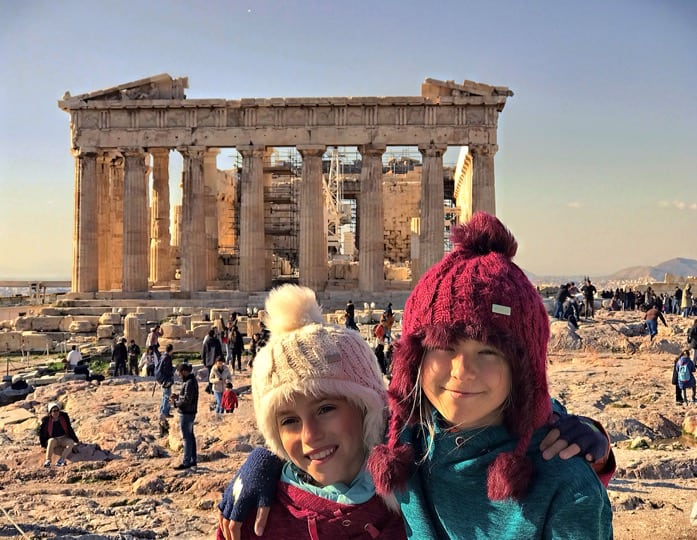
The Parthenon has been used in its history not only as a temple, but also as a Byzantine (Christian) church, and as an Ottoman (Moslem) Mosque and Armoury. Most of the damage to the Parthenon building was caused not by earthquakes but by a Venetian mortar attack in 1687 on the Turkish ammunition dump which was kept there at the time. The attack was in retaliation for the Ottoman conquest of Crete on the sea route from Istanbul to Venice. Ooops!
Tips and Wrinkles for visiting the Acropolis
It’s expensive, but much cheaper off season from November to March. Also off season entry is free to under 25’s who are citizens of the EU but only if you are carrying a copy of your passport or ID to prove both age and citizenship.
If you want to teach your child about Greek Mythology – you should read about “Gods and Men” by Menelaos Stephanides which our girls enjoyed a lot.
The New Acropolis Museum
We were absolutely stunned by this building by Swiss-French architect Bernard Tschumi. From a viewpoint on the Acropolis above, it appears as an ultra-modern glass box sitting slightly askew on top of a more solid building. Then you realise how big it is compared with all the surrounding apartments and offices This one building takes a whole city block. But it is only as you approach from its own level, that you see the museum’s next secret.
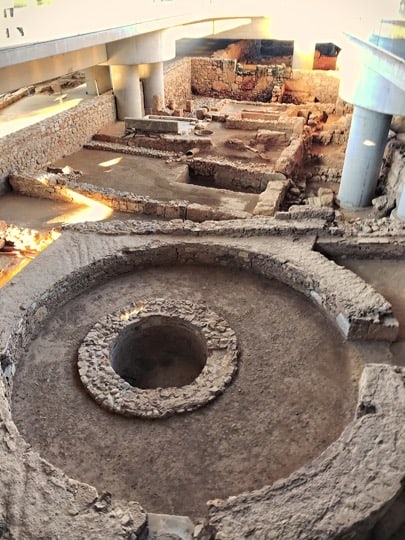
The New Acropolis Museum is sited on the archeological site of a Roman and Byzantine community. The preservation of these remains was not required in the architectural competition won by Tschumi but his design was subsequently elevated to hover above the excavations. Now as you go under the Acropolis Museum you can see the delicate way that the building stands above the preserved excavations and wonder how its vast concrete piles can pierce the ancient remains in surgical precision without the whole site having been destroyed. This heavyweight conjuring trick was achieved by allowing archaeologists to excavate the site, then deciding on the exact placement of the structural columns and marking them with concrete rings. After that the entire site was completely back-filled solid and levelled with graded gravel before the heavy construction equipment was allowed back onto the site to drill the piles and build the frame. Only after the building was finished was the archaeological site re-excavated and the remains restored. The result is awe inspiring and a wonderful testament to how modern design can respect and enhance our heritage.
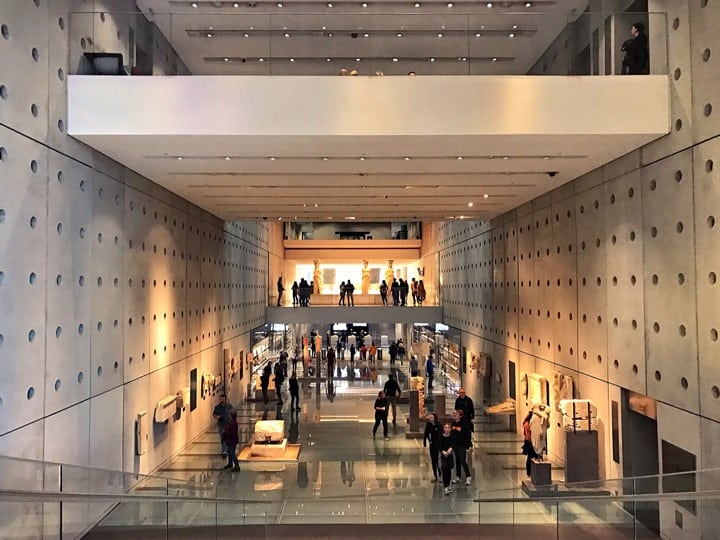
The wonder of this building carries on inside. The route through the exhibitions starts with a long axial corridor rising in level from one end of the building to the other. As you reach the end and look back, – down to the entrance hall, down through the glass floors to the excavations, across to a mezzanine displaying the original Erechtheum caryatids, and up to the Parthenon floor which is also partly glazed, the whole effect is stunning.
The contents of the museum include everything found on the Acropolis and its surroundings which is too delicate to be left standing in the open. They are of course unique and they are beautifully displayed, with bilingual (Greek and English) explanations, and illustrative models.
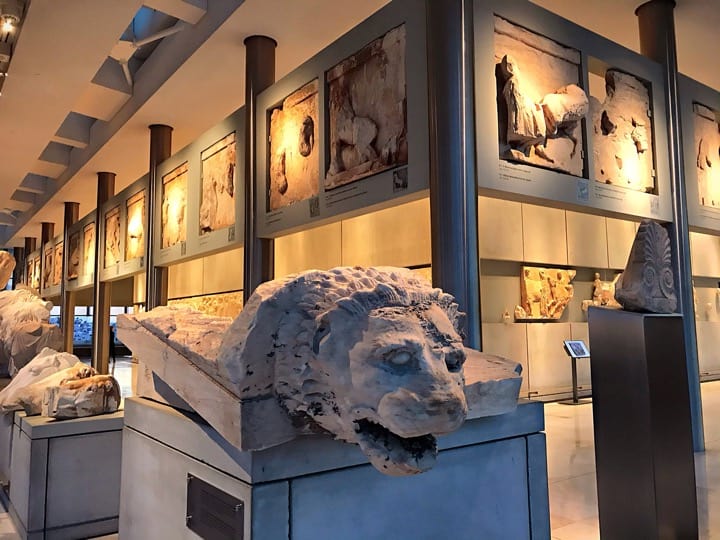
The top floor is the glass box and it is dedicated to the Parthenon, with a film theatre describing its history and restoration. Then around the periphery every piece of sculpture is displayed in a location which copies its original location on the building, but of course now displayed at eye level so it can be seen. Every piece? Well of course not those that are missing, and the most famous of these are the Elgin Marbles. For the story of these, check our post about the Museums of London. (link)The question about whether these priceless relics should be kept in London or Athens has been raging since they were taken away in 1812 – Our verdict? We would send them to this museum this minute.
- Book tickets
- Website
- Google Map Location
- Opening hours – winter season
- Monday – Thursday 9:00 a.m. – 5:00 p.m
- Friday 9:00 a.m. – 10:00 p.m.
- Saturday – Sunday 9:00 a.m. – 8:00 p.m.
- Typical Entry and Other Prices
- Adult: winter season 5€, summer season 10€
- reduced admission 3€ and 5€
- Kids EU:free
National Archaeological Museum Athens
This museum features some of the most important artifacts from archaeological locations across Greece, ranging from prehistoric times to late antiquity. The Archaeological Museum is regarded as among the greatest collections of antiquity on earth. The museum is located in the Exarcheia region in central Athens with its main entrance on Patission Street adjacent to the Athens Polytechnic University.
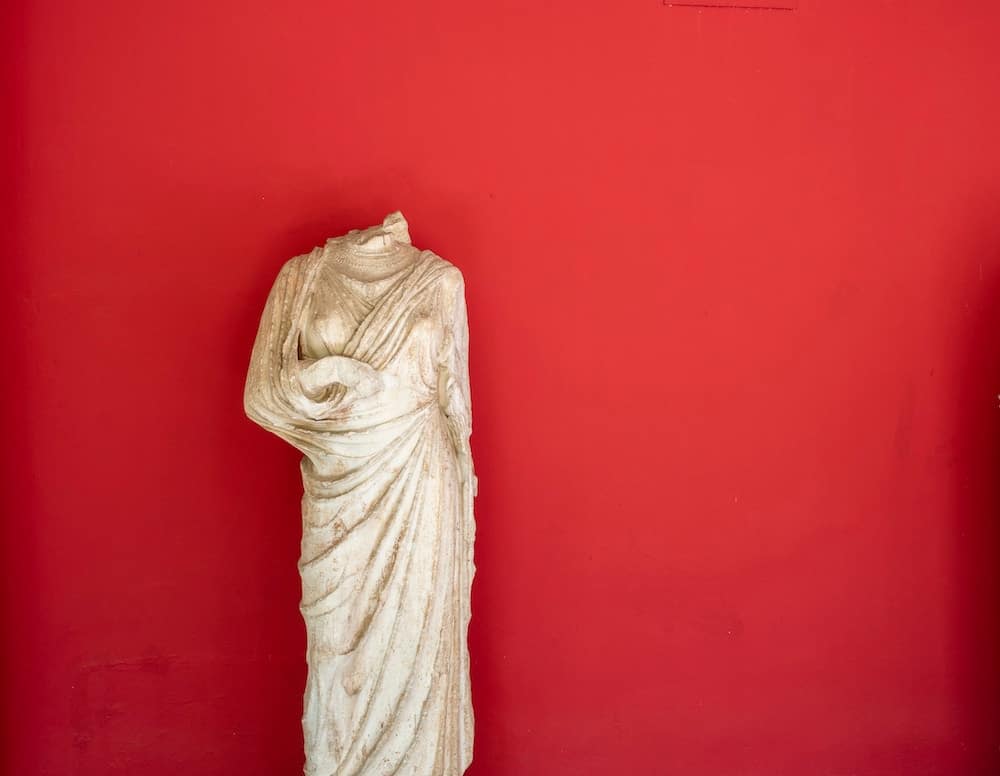
- National Archaeological Museum Athens useful information
- Website
- Google Map Location
- Opening hours
- Monday-1 AM – 8 PM
- Tuesdays – Friday: 9 AM – 8 PM,
- Saturday and Sundays: 9 AM – 4 PM
- Typical Entry and Other Prices
- Adult: high season 12€, low season 6€
Watch the Change of the Guards
The change of guard takes place in front of the Parliament House on Syntagma square at the monument of the Unknown Soldier. The monument is guarded by two elite guards in traditional uniform. Every Sunday at 11 AM, the ceremony of Changing of the Guards takes place. The elite guards known as Evzones are selected as the best of the best and the precision of their marching is impressive.
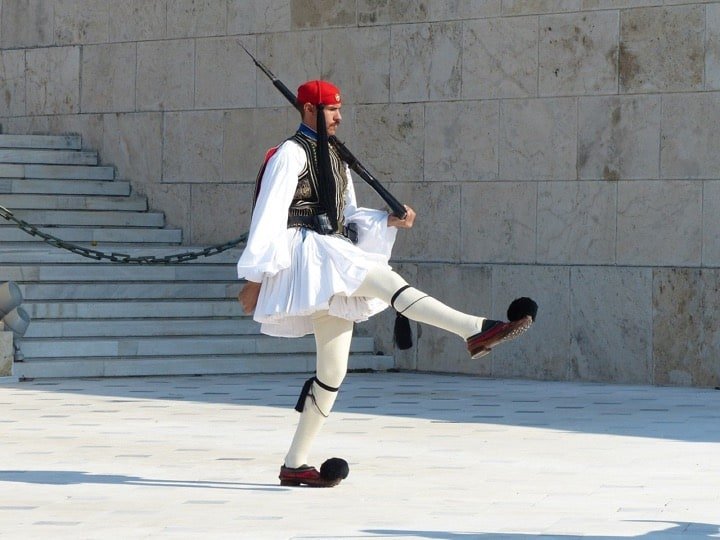
Unfortunately since Monty Python’s sketch about the Ministry of Silly Walks it is difficult to take the ritual as seriously as it is intended, but it’s a lovely place to go on a sunny day with an ice cream from one of the cafes which face the square.
You can actually book a tour of the parliament itself by writing to visits@parliament.gr giving your name, country, email, mobile phone and passport number, and state the date you wish to visit the Parliament. Give a week’s notice before your visit, or learn about it online here:
The ceremony is open to view by the public.
Timing: Every Sunday at 11 AM
Museum of Ancient Greek Technology
The girls loved this place. After two and a half hours inside (we had to drag them out) we discussed it on our walk back to the parking place. The Twins had already awarded it “best museum, worldwide, ever” and spent the rest of the walk skipping along and giggling about whether anywhere else even came close.
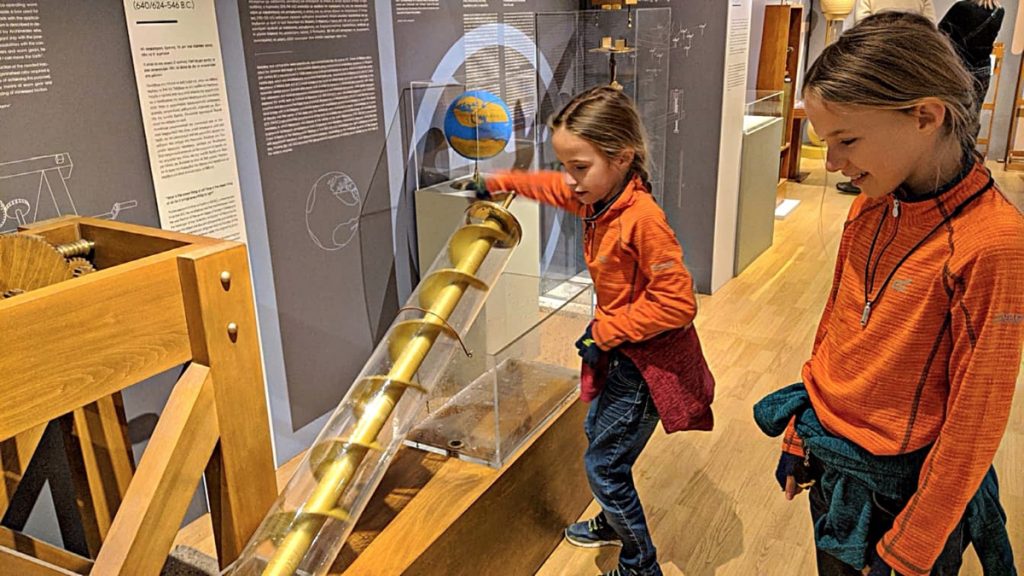
Museum of Ancient Greek Technology is a little with lots of interesting exhibits showing various Greek inventions. There was a (free) English Speaking guide who happily explain and demonstrate different machines. After that, he accompanied us to demonstrate, and sometimes he left us to explore by ourselves. It didn’t really matter – information provided next to each ….. was sufficient.
It’s hand on Museum where you can play with various exhibits. We also saw looms, astrolabes, musical instruments including a pumped pipe organ, the first digital communication system, and we played board games and something like a tangram but with lots more pieces. It’s a great of a place for families.
- Website
- Google Map Location
- Opening hours
- Daily 09:00 – 5:00
- Typical Entry and Other Prices
- Adult: 4€ each exposition
- Child: 4€ each exposition
Wander Around Plaka
Plaka is the oldest neighborhood in Athens. The streets here are all closed to automobile traffic, though motorbikes and delivery trucks are allowed. Once upon a time, Plaka used to be known for its nightlife, but most of the nightclubs closed down after the Greece government outlawed amplified music in the 1970s in an effort to eliminate undesirables. Today, Plaka is lined with fine restaurants, cafés, jewelry stores, and tourist shops. Plaka is one of the nicest neighborhoods in Athens.
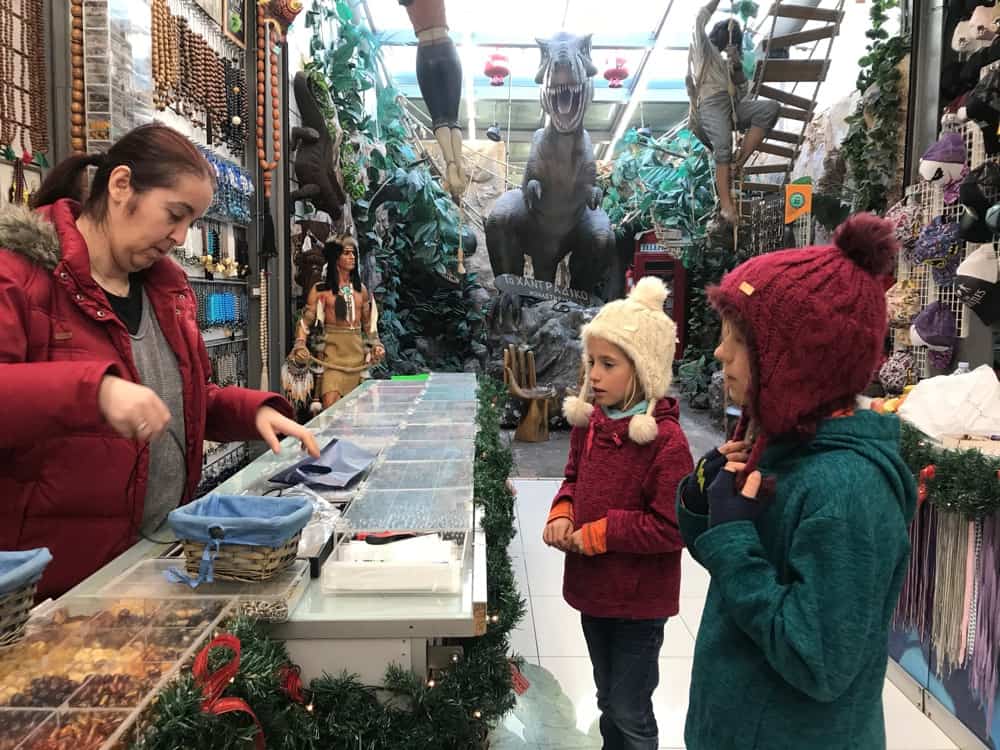
The Plaka is also packed with a lot of archaeological sites both small and large. For example, the Tower of the Winds is located only a few blocks up from Adrianou along Aeolou Street and within the ancient Roman Agora. It is believed that the tower is the gravesite of Phillip of Macedon, but the correct story is that it is a meteorological station built by the Syrian Astronomer Andronikos Kyrrhestes in the first century.
Museums in Plaka
One of the most popular museums in Athens, the Museum of Popular Music is also located in the Plaka, as well as the Platanos Taverna – an old restaurant in a small square near the main shopping area.
Just across from the Tower of Winds is the Doorway of the Medrese, a former theological school from the 1720s. The building was used during the War of Independence as a prison where the Turks tortured and hanged many Greeks.
On the grounds of the Roman Agora are the ruins of the Mosque of Mehmet the Conqueror from 1458. The mosque was built specifically for the Sultan Mehmet when he visited Athens. It was later renamed the Wheat Bazaar Mosque due to the nearby annual wheat market.
Athens Happy Train
The Athens Happy Train is the toy-like train that even the hardest to impress kids will enjoy. The Happy Train starts off from Ermous Street and travels through the Athens city center, passing by some of the major points of interest including the parliament building, a number of the biggest museums in the city, the iconic Panathenaic Stadium, the Lantern of Diogenes, the Temple of Olympian Zeus, and the Plaka neighborhood.
The street train is also a hop-on-hop-off, meaning you can use it as a means of transport between major sites in the city.
http://www.athenshappytrain.com/
- Website
- Every 40 – 50 minutes
- Typical Entry and Other Prices
- Adult: 5€
- Child (xxx years old): $
National History Museum
The National History Museum was founded in 1882 in the Old Parliament House along Stadiou Street in Athens. The building also used to be home to the Hellenic Parliament from 1875 to 1932.
The collection of the Historical and Ethnological Society of Greece (IEEE), founded in 1882, is the oldest collection of its kind in Greece, and before it was moved to the Old Parliament, it was housed in the National Technical University.
- Website
- Google Map Location
- Opening hours
- Daily 8:30 AM – 2:30 PM. Closed on Mondays
- Typical Entry and Other Prices
- Adult:3€
- Child (xxx years old): 1,5€
free on Sundays
Hellenic Motor Museum
Hellenic Motor Museum is a car museum owned by the Theodore Charagionis Foundation. It was opened in 2011 in central Athens close to the National Archaeological Museum, on the third floor of the Athenian Capitol shopping mall.
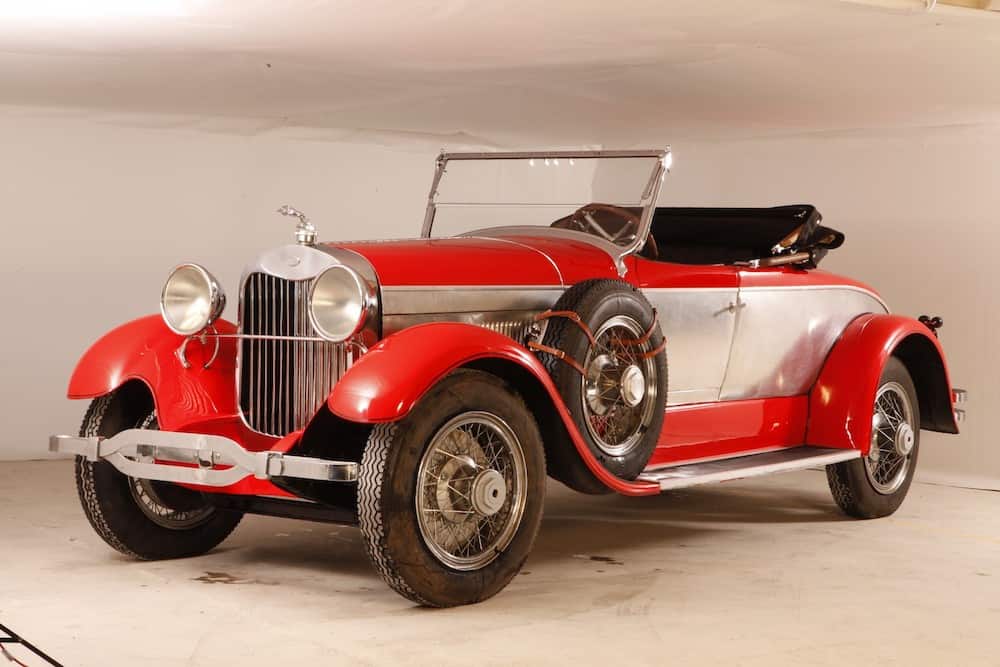
The collection at the museum includes 300 cars, with 110 displayed of these in rotation. The museum also offers other facilities such as Formula 1 simulator, an amphitheater, and a road safety educational program.
- Website
- Google Map Location
- Opening hours
- Monday to Friday 10:00 – 14:00
- Saturday 11:00 – 18:00
- Sunday 11:00 – 18:00
- Typical Entry and Other Prices
- Adult:12€
- Child (6-12 years old): 6€
Hellenic Children’s Museum
Hellenic Children’s Museum is located in two houses designed specifically for children. The museum was featured in the book The Athens Assignment.
- Website
- Google Map Location
- Opening hours vary – refer to the website
- Typical Entry and Other Prices
- Adult:
- Child (3-6 years old): 7€
- Kids(7-14 years old) 8€
The Panathenaic Stadium
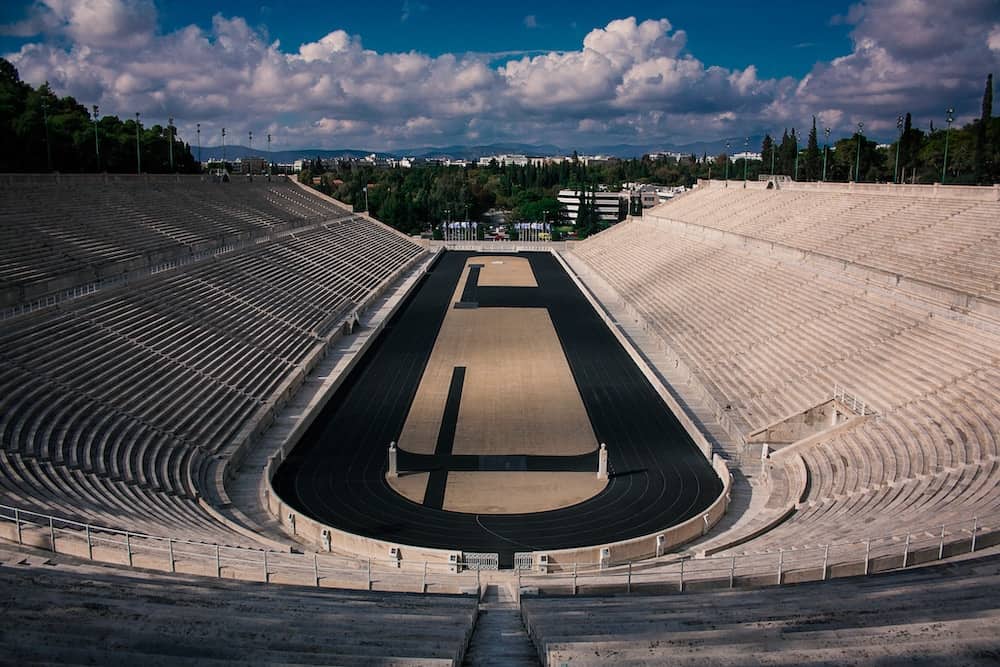
- Website
- Google Map Location
- Opening hours
- Daily 09:00 –
- Typical Entry and Other Prices
- Adult: 5€ (cash only)
- Child (6-18 years old): 2,5€
If you like running (like me) you can go for a morning jog around Panathenaic Stadium but first, you need to fill safety regulation and bring it with for a morning jogging between 7:30 and 9:00
Museum of Illusion
We visited several museums of Illusion like this, and this one like the other was great fun for kids and a bit less for adults, though some of the games were tough. you can easyliy spend here an hour or two and it’s a great change from all the history museums.
- Website
- Google Map Location
- Opening hours
- Monday – Friday 09:00 -09:00
- Saturday – Sunday 10:00 – 10:00
- Typical Entry and Other Prices
- Adult: 9€
- Child (5-18 years old): 6€
Athens with kids – Conclusion
Athens is the most thought-provoking city, inspiring positive thoughts of human creativity for the good. Spend some time there and wonder. We did and we won’t be forgetting it any time soon.
Athens for Kids – pin it

Privacy Policy Disclaimer
This website uses affiliate links for income and support.
If you like our website, please consider using these links. You will be directed to the vendor, and we will get a small commission on your purchase price at no increased cost to you.
We have researched facts stated here as far as practicable but please check anything critical before committing your time and money. We do not claim any special knowledge or expertise, and we are not consultants for our readers.